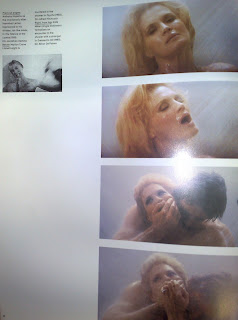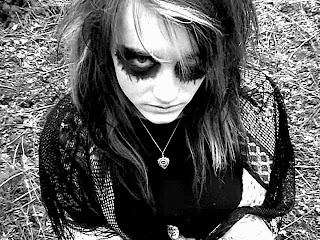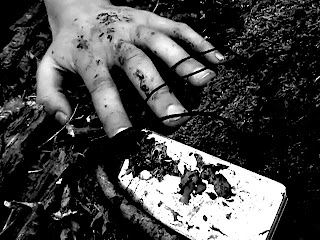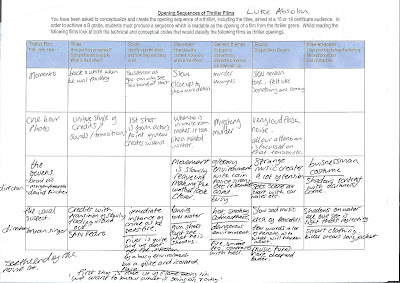Thursday, 30 October 2008
would you believe how many sub genres there are!?
-Action thrillers
-Conspiracy thrillers
-Crime thrillers
-Disaster thrillers
-Drama thrillers
-Eco thrillers
-Erotic thrillers
-Horror thrillers
-Legal thrillers
-Medical thrillers
-Political thrillers
-phsycological thrillers
-Spy thrillers
-Techno thrillers
-Sci-fi thrillers
Luke
Research into history of Thrillers
The following information i got from the book "Cinema Today - By Edward Buscombe)
The film, The God Father (1972) earned around $86 million with a budget of $40-50 thousand. The film was shot in a murky half light to resemble an underworld.
The film: The Terminator 2 (1991)
was the biggest box office success of 1991 and earned over $514 million worldwide with a budget of £80-100 million.
*awarded an oscar for best visual effects and makeup*
It looked like the films which began to introduce clever visual effects and SFX makeup were the ones which were more successfull and made more money overall.
I have also looked at some stills from different successful thriller movies.

above is a still from a film called Dressed to Kill (1980) its a murder in the shower scene where a stranger smothers the woman in the shower. The interesting camera angle gives the viewer a blury vision of the killer which creates a lot of tension as the victim is clueless.
There was also a shower scene in the film Phsyco 1960). Where the woman was murdered, the same way as the other film.
By Luke
Thriller Research Introduction...
History of Thrillers
Throughout the years thrillers have been based on true-life events and scenarios or have even been set during significant periods of time which have been part of history. For example, many thriller films have been set during the time of the Great Depression, the Cold War as well as the Prohibition period,etc. Basing films on actual events means that the audience can easily relate and become more involved with the film, drawing a larger audience as the storyline attracts attention as it is recognised as a realistic and historic event. (A few films which have been based on true-life events are shown below.)
- 'M',(1931) is based on the true story of serial murders that took place in Dusseldorf in Germany.
- Both 'Scarface',(1932) and 'The St Valentines's Day Massacre',(1967) are based on the historical St Valentine's Day Massacre of 1929 when members of one gang were violently murdered by another gang.
Becky.
Wednesday, 15 October 2008
Filming
Becky.
Thursday, 9 October 2008
180 Degree Shot

Reference : picasaweb.google.com/.../ i-pyfeMw_9y_fc0CimVtLQ
Camera 2 would get a shot like this ;

blog.joshuaeichorn.com/.../ ?C=S;O=A
The 180 degree shot is one of the most common shots to use when filming an interview or a conversation between two people. This is why we have been introduced to this shot first because we are in the process of filming our conversations between people in our preliminary exercise. Its a good angle to use because you can get a shot of the interviewee from over the interviewers shoulder, or the other way round and you can also get a full shot of both people.
Becky and Luke.
Friday, 3 October 2008
then and now.

Hi. I thought i would make a post about something i did about a year ago for my media studies btec work. I had to create a 3 minute film trailer for a thriller film. Below is the YouTube link to the video. Take a look!
http://uk.youtube.com/watch?v=cP5yv241HnA
As you can probably tell its very amateur becuase it was the first bit of filming and editing i have ever done.


(above are some stills of the movie that i used when making posters for the final film etc...)
Looking back on the trailer now and along with the new things i have learnt about filming techniques etc especially in thriller films i would have done a lot of things differently. I didnt use many interesting angles or camera movements that make films effective for the viewer.
I also didnt really have a strong story board and only had a rough idea, meaning i had to make some up as i went along.
I should have done much more reseach into thriller trailers too so i would learn exactly what makes it interesting. Not just with the filming but other aspects such as the sound, lighting and editing process.
------------------------------------------------------------------------------------------
In the first two lessons of Media AS, we studied the opening sequences of various thriller films such as: Momento, One hour Photo, The sevens and The usual suspect.

I recorded into the table my views of the different openings to the films. We had to talk about:
titles, shots, camera movement, generic themes, sound, costume, location, setting etc.
All of the films had the common thriller techniques but each one was unique in its own way
Thanks for reading!
Luke :D
Momento opening sequence
Above is the link for the opening sequence of Momento, one of the films that we watched in one of our first media lessons as part of an analysis exercise. Below is my analysis of the opening scenes...
Memento, (starring Guy Pierce and Carrie-Anne Moss) opens with blue, spaced out lettered titles which then fade out onto a black background, accompanied by orchestral backing music. These colours and sound automatically gives us the sense of a dark, intense,eerie and cold atmospheric type film which automatically puts the audience on edge. The first visuals displayed, is a close-up shot of a photograph; the development of the image however is shown in reverse. This continuing generic theme of the reverse of action,(of what appears to be the scenes of a murder) is effective as it is imprinting action into people's memory. Following on from this, more close-up shots of a camera,blood and a bullet are shown. The use of close up shots on these objects empathises and makes it clear to the audience that the objects may have significance and importance, leading the audience to want to know the answers, therefore drawing the audience to watch more.
Becky.




